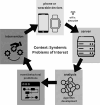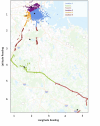Smartphone and Wearable Device-Based Digital Phenotyping to Understand Substance use and its Syndemics
- PMID: 38436819
- PMCID: PMC10959908
- DOI: 10.1007/s13181-024-01000-5
Smartphone and Wearable Device-Based Digital Phenotyping to Understand Substance use and its Syndemics
Abstract
Digital phenotyping is a process that allows researchers to leverage smartphone and wearable data to explore how technology use relates to behavioral health outcomes. In this Research Concepts article, we provide background on prior research that has employed digital phenotyping; the fundamentals of how digital phenotyping works, using examples from participant data; the application of digital phenotyping in the context of substance use and its syndemics; and the ethical, legal and social implications of digital phenotyping. We discuss applications for digital phenotyping in medical toxicology, as well as potential uses for digital phenotyping in future research. We also highlight the importance of obtaining ground truth annotation in order to identify and establish digital phenotypes of key behaviors of interest. Finally, there are many potential roles for medical toxicologists to leverage digital phenotyping both in research and in the future as a clinical tool to better understand the contextual features associated with drug poisoning and overdose. This article demonstrates how medical toxicologists and researchers can progress through phases of a research trajectory using digital phenotyping to better understand behavior and its association with smartphone usage.
Keywords: Digital Phenotyping; Smartphone; Substance use; Syndemics; Wearable.
© 2024. American College of Medical Toxicology.
Figures




Similar articles
-
A Call to Expand the Scope of Digital Phenotyping.J Med Internet Res. 2023 Mar 14;25:e39546. doi: 10.2196/39546. J Med Internet Res. 2023. PMID: 36917148 Free PMC article.
-
Systematic Review of Digital Phenotyping and Machine Learning in Psychosis Spectrum Illnesses.Harv Rev Psychiatry. 2020 Sep/Oct;28(5):296-304. doi: 10.1097/HRP.0000000000000268. Harv Rev Psychiatry. 2020. PMID: 32796192
-
Ethical Development of Digital Phenotyping Tools for Mental Health Applications: Delphi Study.JMIR Mhealth Uhealth. 2021 Jul 28;9(7):e27343. doi: 10.2196/27343. JMIR Mhealth Uhealth. 2021. PMID: 34319252 Free PMC article.
-
HOPES: An Integrative Digital Phenotyping Platform for Data Collection, Monitoring, and Machine Learning.J Med Internet Res. 2021 Mar 15;23(3):e23984. doi: 10.2196/23984. J Med Internet Res. 2021. PMID: 33720028 Free PMC article.
-
Smartphone digital phenotyping in mental health disorders: A review of raw sensors utilized, machine learning processing pipelines, and derived behavioral features.Psychiatry Res. 2025 Jun;348:116483. doi: 10.1016/j.psychres.2025.116483. Epub 2025 Apr 1. Psychiatry Res. 2025. PMID: 40187059 Review.
Cited by
-
Leveraging A Digital Pill System to Understand Prevention-Effective Adherence to Oral Hiv Pre-Exposure Prophylaxis Among Men Who Have Sex with Men with Substance Use.AIDS Behav. 2024 Oct;28(10):3373-3380. doi: 10.1007/s10461-024-04435-7. Epub 2024 Jul 10. AIDS Behav. 2024. PMID: 38985403 Free PMC article.
References
-
- Pew Research Center. Mobile Fact Sheet [Internet]. Pew Research Center: Internet, Science & Tech. [cited 2023 Nov 21]. Available from: https://www.pewresearch.org/internet/fact-sheet/mobile/.
-
- Wike R, Silver L, Fetterold J, Huang C, Austin S, Clancy L et al. Internet, smartphone and social media use [Internet]. Pew Research Center’s Global Attitudes Project. 2022 [cited 2023 Nov 21]. Available from: https://www.pewresearch.org/global/2022/12/06/internet-smartphone-and-so....
-
- Silver L. Smartphone Ownership Is Growing Rapidly Around the World, but Not Always Equally [Internet]. Pew Research Center’s Global Attitudes Project. 2019 [cited 2023 Nov 21]. Available from: https://www.pewresearch.org/global/2019/02/05/smartphone-ownership-is-gr....
-
- De Jesus VLB, Pérez CAC, De Oliveira AL, Sasaki DGG. Understanding the gyroscope sensor: a quick guide to teaching rotation movements using a smartphone. Phys Educ. 2019;54:015003. doi: 10.1088/1361-6552/aae3fc. - DOI
MeSH terms
Grants and funding
LinkOut - more resources
Full Text Sources
Medical

